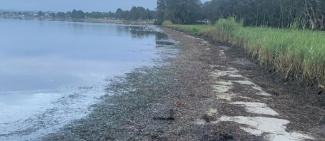Adaptability is one of the most beneficial features of the lake's entrance. It can open wide when the lake floods to release the floodwater. Between flood events, it shoals up and protects our public spaces, infrastructure and environmental assets from coastal storms. The entrance also provides a quiet area for birds to nest, people to swim and small watercraft to travel. The estuary is well-adapted to these dynamic conditions, and they are crucial to its ecological health.
A rock shelf located at the mouth of the estuary affects both the width and depth of the channel, and influences where it scours and how the entrance opens. The rock shelf also protects the land and assets inside the channel from coastal impacts, both during average conditions and when sea levels rise.
Before the 1960s, the lakes' entrance was allowed to close over during periods of low rainfall. When there was rain in the catchment, the lakes would fill up to a point, then scour the sand shoals and beach berm, opening the channel.
When the lake was left to shoal up naturally, water levels throughout the estuary varied much more than they do now. This natural fluctuation allowed the lake edges to self-cleanse.
The water level in the estuary rises between the average of 0.25m and around 0.9m AHD. When this happens, the lake water spills over the edges and onto the shallow shoreline areas. While this doesn't have any significant effect on recreational use of the foreshores or the water infrastructure, it is an extremely beneficial natural process. When the water level is higher, many kinds of organic material that sits in the lake – granular silt, wrack such as seagrass leaves, macroalgae, and driftwood, or other types of sludgy sediment – wash up onto the shore. As soon as the water recedes, this material is left to dry, leaving the lakes’ edges cleaner. This process is very important as the shallow waters in the catchment are becoming increasingly polluted.


